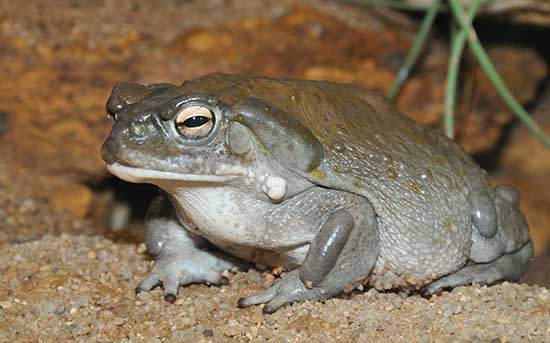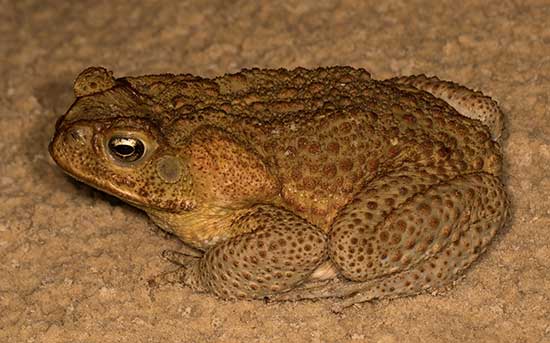The Poisonous Threat to Your Dog You Probably Aren't Aware Of
Small but deadly, you'd probably be surprised to learn just how many dogs suffer from this toxin each year. Even if it merely touches your dog's water dish, it could prove fatal. Know the signs, because every wasted minute could cut your pup's chance of survival.

STORY AT-A-GLANCE
- Certain toad species secrete a deadly toxin through their skin. Dogs are typically exposed when they pick up one of these toads in their mouth
- Signs of toad venom toxicity appear within seconds to minutes after exposure, and emergency treatment is required to save the pet’s life
- The two most common species of deadly toads are the Sonoran Desert or Colorado River toad, and the Marine or Cane toad. These toads are found only in a few US states
Editor's Note: This article is a reprint. It was originally published July 01, 2015.
You might be surprised to know that toad poisoning in dogs is not uncommon. Over a 4-year period, Veterinary Pet Insurance (VPI) processed almost 300 claims from pet guardians whose dog (or much less often, cat) had an encounter with a deadly toad. In fact, it was one of the top 10 types of poisonings during that 4-year period.1
And keep in mind those numbers don't include the toad-poisoned dogs of pet owners without pet insurance (which is most of them).
How Dogs Get Poisoned by Toads
Many dogs view toads as prey and catch them in their mouths. All toads secrete a substance through their skin that is foul tasting to other animals, but deadly species of toads, when threatened, secrete a highly toxic chemical that is absorbed through membranes in the dog's mouth, and sometimes the eyes.
The toxin is similar to the human heart medication digoxin and consists of compounds called bufotoxins and bufodienolids, and biogenic amines such as bufotenins, bufotionins, epinephrine, and serotonin that are produced in the toad's parotid glands and skin. As the dog mouths, licks, or chews the toad, the glands are compressed, which secretes the toxin.
Less commonly, the toxin is absorbed through wounds or broken skin, and there have also been reports of poisoning as the result of toads sitting in a pet's water bowl, or even just the lip of the bowl.
Symptoms of Toad Venom Toxicity
If your dog comes in contact with a toxic toad, he'll exhibit one or more of the following symptoms almost immediately:
- Severe drooling
- Head shaking
- Pawing at the mouth or eyes
- Mucous membranes that turn a muddy red color
- Hyperthermia (overheating)
- Difficulty breathing
- Vomiting of yellow fluid
- Diarrhea
- Neurological signs such as dilated pupils, loss of coordination, vocalization, seizures, collapse, and death
Toad poisoning is a life-threatening medical emergency. If you know or suspect your pet has been exposed to a deadly species of toad, rinse his mouth out immediately (preferably with a constant stream of water from a faucet or hose) and call your veterinarian, the closest emergency animal hospital, and/or the Pet Poison Helpline at 855-764-7661.
Diagnosing Toad Venom Toxicity
If a veterinarian is checking for possible toad poisoning in a dog, he or she will perform a physical exam and run a complete blood count (CBC), blood chemistry profile, and urinalysis.
The results of these tests are typically normal, however, there is often an unusually high level of potassium (a condition called hyperkalemia), and the dog may also have an abnormal heartbeat. Certainly if your pet is exhibiting symptoms of toad venom toxicity, your veterinarian will use that information as well in making a diagnosis.
Treatment Protocol for Toad Toxicity
The first step in treating toad toxicity is to flush the dog's mouth with large amounts of water for 5 to 10 minutes to prevent further absorption of the venom. Often this is done under anesthesia so the entire mouth and throat can be thoroughly flushed. Activated charcoal may also be administered.
Since an abnormal heart rhythm is a common symptom of this type of poisoning, your veterinarian will monitor your dog's heart function and response to treatment using an electrocardiogram (EKG). Drugs may be used to control an abnormal heartbeat.
Your dog may also need to be placed in a cool bath to keep her body temperature stable. IV fluids will be administered to keep her hydrated and to manage seizures. Sedation may be necessary, especially for dogs in obvious pain or extreme distress. Your dog will need to be continuously monitored until she is fully recovered.
If your dog has been exposed to a toxic toad, time is your enemy, so it's crucial that you get your pet to your veterinarian or an emergency animal clinic immediately. Pets that are treated before the toxin is fully absorbed, within about 30 minutes, have the best chance of recovery. Unfortunately, the overall prognosis is not good, and death is very common in dogs exposed to toad venom.
Poisonous Toad Species
The two most well-known species of toad that are deadly to pets are the Sonoran Desert or Colorado River toad (Incilius alvarius, formerly known as Bufo alvarius) and the Marine or Cane toad (Rhinella marinus, formerly known as Bufo marinus.


These toads are quite large, reaching 8 or 9 inches in length as adults. They are typically only found in and between Arizona and California, as well as in Texas, Florida, Hawaii, and other tropical areas. Of the two species, the Marine or Cane toad is considered more poisonous.
Most cases of toad poisoning occur during the warmest months of summer when humidity is high and the toads are more active. Dogs usually encounter the toads in the early morning or after dark.
The toads are omnivores. Their natural diet is insects and small rodents, but they will also eat pet food left outdoors. This is often how pets come into contact when them — at an outdoor food or water bowl. It's advisable if you live in an area these toads inhabit, that you not leave pet food or water outside.











